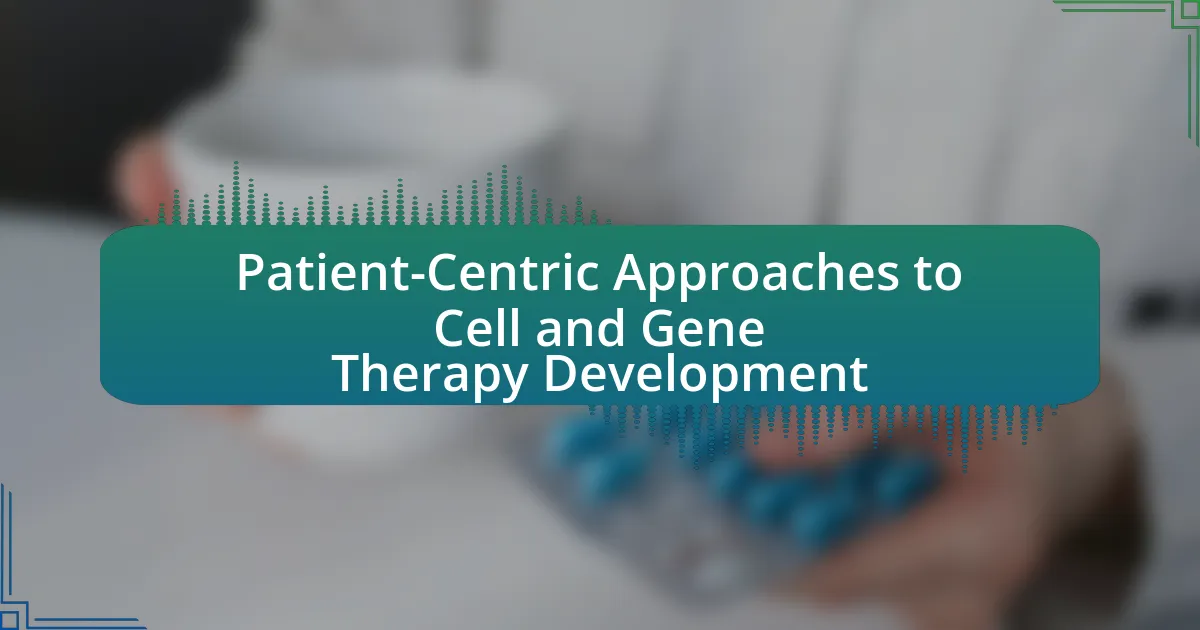The article focuses on the barriers to the widespread adoption of cell therapies, highlighting regulatory challenges, high costs, and limited manufacturing capabilities as primary obstacles. It examines how stringent regulatory processes, particularly those enforced by the FDA, prolong the approval timeline and increase development costs, thereby deterring investment. Economic factors, including reimbursement issues and the high costs of cell therapies compared to traditional treatments, further complicate their accessibility. The article also discusses the importance of public perception, education, and collaboration among stakeholders in overcoming these barriers, while exploring potential strategies to enhance the integration of cell therapies into standard medical practice.

What are the key barriers to the widespread adoption of cell therapies?
The key barriers to the widespread adoption of cell therapies include regulatory challenges, high costs, and limited access to manufacturing capabilities. Regulatory challenges arise from the complex approval processes required by agencies like the FDA, which can delay the introduction of new therapies. High costs are associated with research, development, and production, making these therapies financially burdensome for healthcare systems and patients. Limited access to manufacturing capabilities restricts the ability to produce cell therapies at scale, further hindering their availability. These factors collectively impede the integration of cell therapies into standard medical practice.
How do regulatory challenges impact the adoption of cell therapies?
Regulatory challenges significantly hinder the adoption of cell therapies by creating lengthy approval processes and increasing costs for developers. These challenges often involve complex requirements for clinical trials, safety assessments, and manufacturing standards, which can delay the introduction of innovative therapies to the market. For instance, the U.S. Food and Drug Administration (FDA) has stringent guidelines that require extensive preclinical and clinical data to demonstrate safety and efficacy, leading to increased timeframes for product development. According to a report by the Alliance for Regenerative Medicine, the average time for a cell therapy to reach the market can exceed 10 years, primarily due to regulatory hurdles. This prolonged timeline can deter investment and innovation in the field, ultimately limiting patient access to potentially life-saving treatments.
What specific regulations hinder the development of cell therapies?
Specific regulations that hinder the development of cell therapies include stringent FDA approval processes, which require extensive preclinical and clinical trial data to demonstrate safety and efficacy. These regulations are designed to protect patients but can significantly delay the introduction of innovative therapies. For instance, the FDA’s requirement for Investigational New Drug (IND) applications mandates comprehensive documentation, including manufacturing processes, quality control measures, and detailed clinical trial protocols. Additionally, the complexity of regulatory frameworks across different countries creates further challenges, as companies must navigate varying standards and requirements, which can lead to increased costs and extended timelines for bringing cell therapies to market.
How can regulatory pathways be streamlined for cell therapies?
Regulatory pathways for cell therapies can be streamlined by implementing adaptive licensing frameworks that allow for iterative data submission and review. This approach facilitates faster access to therapies while ensuring safety and efficacy through real-world evidence collection. For instance, the European Medicines Agency has adopted a similar model, which has shown to reduce timeframes for approval without compromising regulatory standards. Additionally, harmonizing regulations across jurisdictions can minimize duplication of efforts and resources, further expediting the approval process.
What economic factors affect the adoption of cell therapies?
Economic factors significantly influence the adoption of cell therapies, primarily through high development costs, reimbursement challenges, and market access issues. The development of cell therapies often requires substantial investment in research and clinical trials, with costs reaching billions of dollars, which can deter companies from pursuing these innovations. Additionally, reimbursement policies from insurance providers can create barriers; if cell therapies are not adequately covered, patients may be unable to afford them, limiting their market penetration. Furthermore, regulatory hurdles and the need for extensive evidence of efficacy and safety can delay market access, impacting the overall adoption rate. These economic factors collectively shape the landscape for cell therapies, determining their availability and accessibility to patients.
How do costs of cell therapies compare to traditional treatments?
Cell therapies generally have higher costs compared to traditional treatments. For instance, the average cost of CAR-T cell therapy can exceed $373,000 per patient, while traditional cancer treatments, such as chemotherapy, typically range from $10,000 to $100,000 depending on the regimen and duration. This significant price difference is attributed to the complex manufacturing processes, personalized nature of cell therapies, and the need for specialized medical facilities and personnel.
What funding opportunities exist for cell therapy research and development?
Funding opportunities for cell therapy research and development include government grants, private sector investments, and philanthropic contributions. For instance, the National Institutes of Health (NIH) provides substantial funding through various grant programs specifically aimed at advancing cell therapy innovations. Additionally, venture capital firms and biotechnology companies actively invest in promising cell therapy startups, recognizing the potential for high returns in this rapidly evolving field. Philanthropic organizations, such as the Michael J. Fox Foundation, also offer grants to support research focused on specific diseases treatable by cell therapies. These funding sources collectively enhance the financial landscape for researchers and developers in the cell therapy sector.
How does public perception influence the acceptance of cell therapies?
Public perception significantly influences the acceptance of cell therapies by shaping individuals’ trust and willingness to engage with these medical innovations. Positive public perception can lead to increased demand for cell therapies, as seen in surveys where patients express a preference for advanced treatments when they understand their benefits and safety profiles. Conversely, negative perceptions, often fueled by misinformation or fear of side effects, can hinder acceptance, as evidenced by studies indicating that public skepticism about the safety of stem cell treatments correlates with lower participation rates in clinical trials. Thus, the relationship between public perception and acceptance is critical in determining the success and integration of cell therapies into mainstream healthcare.
What misconceptions exist about cell therapies among the public?
Misconceptions about cell therapies among the public include the belief that these treatments are universally effective, safe, and free from side effects. Many individuals assume that all cell therapies can cure diseases, ignoring the fact that efficacy varies by condition and therapy type. Additionally, there is a widespread notion that cell therapies are fully approved and regulated, while many are still in experimental stages and not yet validated by rigorous clinical trials. This misunderstanding can lead to unrealistic expectations and potential exploitation by unregulated providers.
How can education and outreach improve public understanding of cell therapies?
Education and outreach can significantly improve public understanding of cell therapies by providing accurate information and addressing misconceptions. Effective educational programs can clarify the science behind cell therapies, explain their potential benefits and risks, and highlight real-world applications, thereby fostering informed decision-making. For instance, initiatives like community workshops and informational campaigns have been shown to increase awareness and knowledge about medical advancements, as evidenced by studies indicating that targeted outreach can enhance public perception and acceptance of innovative treatments. By engaging with diverse audiences through accessible formats, education and outreach can bridge knowledge gaps and promote a more informed public discourse on cell therapies.

What strategies can be employed to overcome these barriers?
To overcome barriers to the widespread adoption of cell therapies, strategies such as enhancing regulatory frameworks, increasing funding for research, and improving public awareness can be employed. Strengthening regulatory frameworks ensures that cell therapies meet safety and efficacy standards, which can facilitate faster approvals and market entry. Increased funding for research can drive innovation and reduce costs associated with developing these therapies, making them more accessible. Additionally, improving public awareness through education campaigns can help demystify cell therapies, addressing misconceptions and fostering acceptance among patients and healthcare providers. These strategies collectively address the critical barriers of regulation, funding, and public perception, thereby promoting the adoption of cell therapies.
How can collaboration between stakeholders enhance cell therapy adoption?
Collaboration between stakeholders can enhance cell therapy adoption by fostering shared knowledge, resources, and regulatory alignment. When pharmaceutical companies, healthcare providers, researchers, and regulatory bodies work together, they can streamline the development and approval processes, reducing time and costs associated with bringing therapies to market. For instance, collaborative initiatives like the Alliance for Regenerative Medicine have successfully advocated for clearer regulatory pathways, which has been shown to accelerate the approval of cell therapies. Additionally, partnerships can facilitate clinical trials by pooling resources and expertise, leading to more robust data that supports the efficacy and safety of therapies, ultimately increasing confidence among healthcare providers and patients.
What roles do academic institutions play in advancing cell therapies?
Academic institutions play a crucial role in advancing cell therapies by conducting foundational research, developing innovative techniques, and training the next generation of scientists. They contribute to the understanding of cellular mechanisms and therapeutic applications through rigorous scientific studies, often leading to breakthroughs in treatment methodologies. For instance, research conducted at institutions like Stanford University has led to significant advancements in CAR-T cell therapy, demonstrating the potential of engineered T cells in treating cancers. Furthermore, academic institutions often collaborate with industry partners to translate research findings into clinical applications, thereby facilitating the transition from laboratory discoveries to real-world therapies. This collaboration is essential for overcoming regulatory and logistical barriers, ultimately promoting the widespread adoption of cell therapies.
How can partnerships between industry and government facilitate progress?
Partnerships between industry and government can facilitate progress by aligning resources, expertise, and regulatory frameworks to accelerate the development and adoption of cell therapies. For instance, collaborative initiatives can streamline the regulatory approval process, as seen in the FDA’s Breakthrough Therapy Designation, which expedites the review of therapies that demonstrate substantial improvement over existing treatments. Additionally, joint funding programs can support research and development, exemplified by the National Institutes of Health’s partnerships with biotech firms to advance innovative therapies. These collaborations enhance knowledge sharing and foster innovation, ultimately leading to more effective and accessible cell therapies for patients.
What innovations in technology can support the adoption of cell therapies?
Innovations in technology that can support the adoption of cell therapies include advanced manufacturing techniques, automation in cell processing, and improved delivery systems. Advanced manufacturing techniques, such as bioreactors and closed-system processing, enhance the scalability and consistency of cell production, which is crucial for meeting patient demand. Automation in cell processing reduces human error and increases efficiency, allowing for faster turnaround times in therapy preparation. Improved delivery systems, including targeted delivery mechanisms and smart biomaterials, enhance the effectiveness of cell therapies by ensuring that therapeutic cells reach the intended site of action. These technological advancements collectively address key challenges in the scalability, safety, and efficacy of cell therapies, facilitating their broader implementation in clinical settings.
How can advancements in manufacturing processes improve cell therapy scalability?
Advancements in manufacturing processes can significantly improve cell therapy scalability by enabling more efficient production methods and reducing costs. For instance, the implementation of automated bioreactors allows for higher cell yields and consistent quality, which is crucial for large-scale production. Additionally, innovations such as closed-system processing minimize contamination risks and streamline workflows, further enhancing scalability. According to a study published in “Nature Biotechnology,” these advancements can lead to a 50% reduction in production time and a 30% decrease in costs, making cell therapies more accessible to a broader patient population.
What role does data management play in the development of cell therapies?
Data management is crucial in the development of cell therapies as it ensures the accurate collection, storage, and analysis of vast amounts of biological and clinical data. Effective data management facilitates regulatory compliance, enhances the reproducibility of results, and supports the identification of patient-specific factors that influence therapy outcomes. For instance, the integration of data from clinical trials and patient registries allows researchers to track treatment efficacy and safety, ultimately guiding the optimization of therapeutic protocols. Furthermore, robust data management systems enable real-time monitoring of cell therapy processes, which is essential for maintaining quality control and ensuring patient safety.
How can policy changes promote the growth of cell therapies?
Policy changes can promote the growth of cell therapies by streamlining regulatory processes and increasing funding for research and development. Streamlined regulations can reduce the time and cost associated with bringing new therapies to market, as seen in the FDA’s Breakthrough Therapy designation, which expedites the review process for promising treatments. Increased funding, such as grants and tax incentives for companies developing cell therapies, can enhance innovation and attract investment, evidenced by the $1.5 billion allocated by the National Institutes of Health for regenerative medicine research in 2020. These policy adjustments create a more favorable environment for the advancement and accessibility of cell therapies.
What specific policies could incentivize investment in cell therapy research?
Specific policies that could incentivize investment in cell therapy research include tax credits for research and development, streamlined regulatory pathways, and public-private partnerships. Tax credits can reduce the financial burden on companies investing in innovative therapies, as evidenced by the U.S. R&D tax credit, which has been shown to stimulate increased investment in biotechnology. Streamlined regulatory pathways, such as the FDA’s Breakthrough Therapy Designation, can expedite the approval process for promising therapies, encouraging companies to invest more resources. Public-private partnerships can leverage government funding to support research initiatives, as seen in the collaboration between the National Institutes of Health and private biotech firms, which has successfully advanced cell therapy projects.
How can international collaboration shape global cell therapy standards?
International collaboration can shape global cell therapy standards by facilitating the sharing of research, regulatory practices, and clinical data among countries. This collaboration enables the establishment of unified protocols and guidelines that enhance safety and efficacy in cell therapies. For instance, initiatives like the International Society for Cell & Gene Therapy promote harmonization of regulatory frameworks, which can lead to more consistent approval processes across different regions. Furthermore, collaborative research projects can pool resources and expertise, accelerating the development of innovative therapies and ensuring that diverse patient populations are considered in clinical trials. Such efforts are crucial for overcoming barriers to widespread adoption, as they create a more cohesive and efficient global landscape for cell therapy advancements.

What are the future prospects for cell therapies in healthcare?
The future prospects for cell therapies in healthcare are highly promising, with advancements in technology and research driving their potential applications. Innovations such as gene editing, particularly CRISPR technology, are enhancing the efficacy of cell therapies, allowing for more precise targeting of diseases. Additionally, the global market for cell therapy is projected to reach approximately $8 billion by 2025, indicating significant investment and interest in this field. Clinical trials are expanding, with over 1,000 ongoing studies focused on various conditions, including cancer and genetic disorders, demonstrating the growing acceptance and integration of cell therapies into mainstream medicine.
How might emerging research change the landscape of cell therapies?
Emerging research is poised to significantly transform the landscape of cell therapies by enhancing their efficacy, safety, and accessibility. For instance, advancements in gene editing technologies, such as CRISPR-Cas9, enable precise modifications of cell genomes, which can improve therapeutic outcomes for conditions like genetic disorders and cancers. Additionally, studies on the use of induced pluripotent stem cells (iPSCs) are expanding the potential for personalized medicine, allowing for patient-specific therapies that reduce the risk of immune rejection. Research published in “Nature Biotechnology” by Takahashi and Yamanaka highlights the potential of iPSCs in regenerative medicine, demonstrating their ability to differentiate into various cell types. Furthermore, the development of off-the-shelf cell products, as explored in recent clinical trials, aims to lower costs and streamline production processes, making cell therapies more widely available. These innovations collectively address existing barriers, paving the way for broader adoption and integration of cell therapies into standard medical practice.
What breakthroughs are currently being explored in cell therapy research?
Current breakthroughs in cell therapy research include advancements in gene editing technologies, such as CRISPR-Cas9, which enable precise modifications of cellular genomes to treat genetic disorders. Additionally, researchers are exploring the use of induced pluripotent stem cells (iPSCs) to generate patient-specific cells for regenerative medicine, enhancing the potential for personalized therapies. Studies have shown that these approaches can improve the efficacy and safety of treatments for conditions like cancer and autoimmune diseases, as evidenced by clinical trials demonstrating successful outcomes in patients receiving engineered T-cell therapies.
How can personalized medicine integrate with cell therapies?
Personalized medicine can integrate with cell therapies by tailoring treatment protocols based on individual patient genetic profiles and disease characteristics. This integration allows for the selection of specific cell types and modifications that enhance therapeutic efficacy and minimize adverse effects. For instance, CAR-T cell therapies are designed to target unique tumor antigens present in a patient’s cancer cells, demonstrating the effectiveness of personalized approaches in improving treatment outcomes. Studies have shown that personalized cell therapies can lead to higher response rates and improved survival in patients with certain types of cancers, validating the importance of this integration in advancing cell therapy applications.
What lessons can be learned from successful cell therapy implementations?
Successful cell therapy implementations demonstrate the importance of robust regulatory frameworks, comprehensive patient selection criteria, and effective manufacturing processes. Regulatory frameworks, such as those established by the FDA, ensure that therapies meet safety and efficacy standards, which builds public trust and facilitates market access. Comprehensive patient selection criteria, as seen in trials for CAR T-cell therapies, enhance treatment outcomes by identifying individuals most likely to benefit. Effective manufacturing processes, exemplified by companies like Novartis, streamline production and reduce costs, making therapies more accessible. These lessons highlight the critical components necessary for overcoming barriers to the widespread adoption of cell therapies.
What case studies highlight effective adoption of cell therapies?
Case studies that highlight effective adoption of cell therapies include the use of CAR T-cell therapy in treating certain types of blood cancers, such as acute lymphoblastic leukemia (ALL) and diffuse large B-cell lymphoma (DLBCL). In clinical trials, such as those conducted by Novartis with Kymriah and Gilead with Yescarta, patients demonstrated significant remission rates, with Kymriah achieving a 90% remission rate in pediatric ALL patients. These therapies exemplify successful integration into treatment protocols, showcasing the potential of cell therapies to transform cancer care.
How can these lessons inform future strategies for overcoming barriers?
Lessons learned from previous challenges in cell therapy adoption can guide future strategies by emphasizing the importance of regulatory clarity, stakeholder engagement, and education. For instance, understanding the regulatory hurdles faced by earlier therapies can lead to streamlined approval processes, as seen in the accelerated pathways established by the FDA for breakthrough therapies. Engaging with healthcare providers and patients can foster trust and improve acceptance, as demonstrated by successful outreach programs in other medical fields. Additionally, educating both practitioners and patients about the benefits and risks of cell therapies can mitigate misconceptions, similar to initiatives that have effectively increased vaccination rates. These strategies, grounded in past experiences, can significantly enhance the likelihood of successful implementation and acceptance of cell therapies in clinical practice.
What practical steps can stakeholders take to facilitate the adoption of cell therapies?
Stakeholders can facilitate the adoption of cell therapies by investing in research and development, establishing regulatory frameworks, and enhancing education and training programs. Investment in research accelerates innovation and improves therapy efficacy, as evidenced by the $4.5 billion invested in cell therapy research in 2020, which led to significant advancements in treatment options. Establishing clear regulatory frameworks ensures safety and efficacy, as seen in the FDA’s guidance on cell therapy products, which streamlines the approval process. Additionally, enhancing education and training programs for healthcare professionals increases awareness and understanding of cell therapies, leading to better patient outcomes and increased acceptance in clinical settings.




